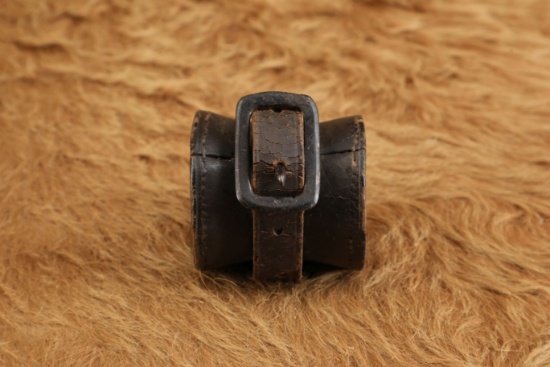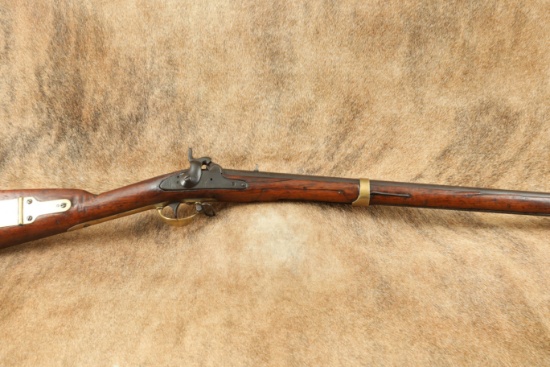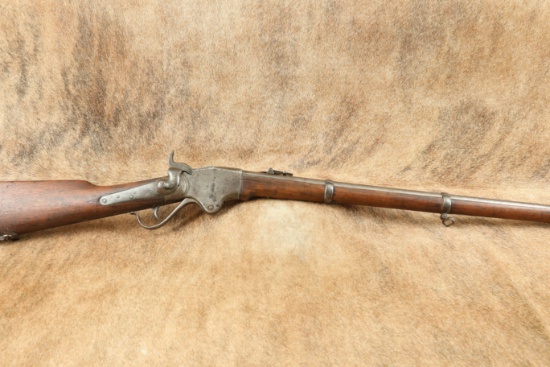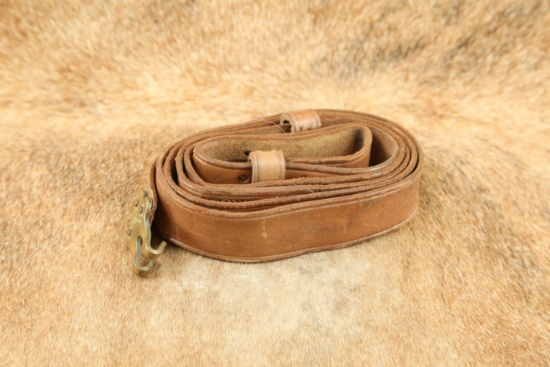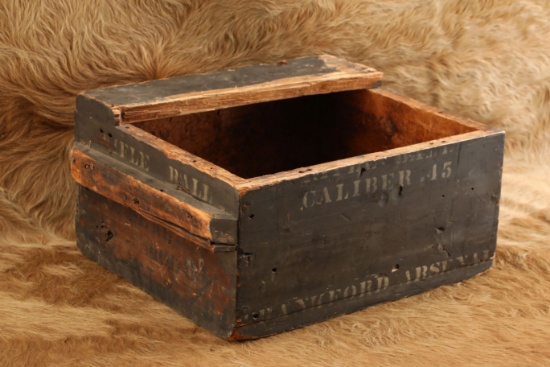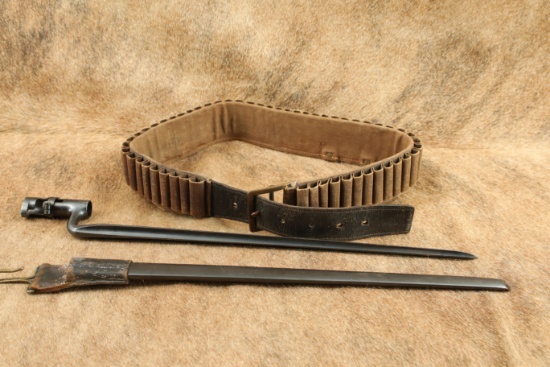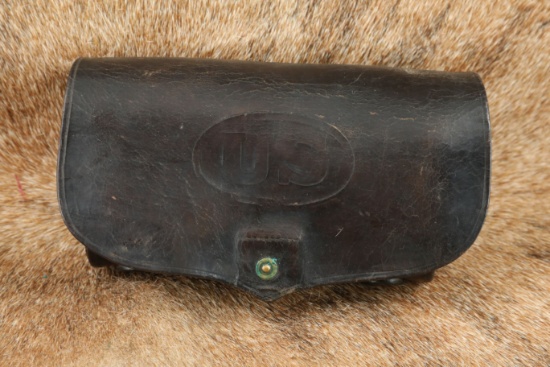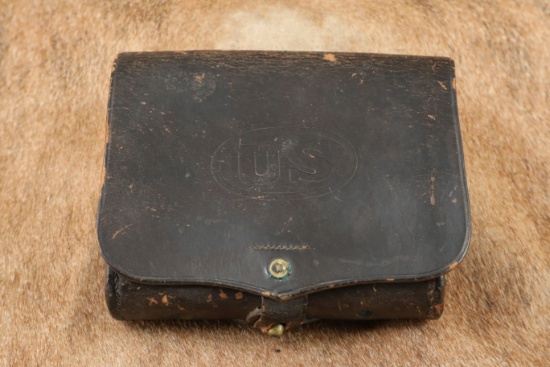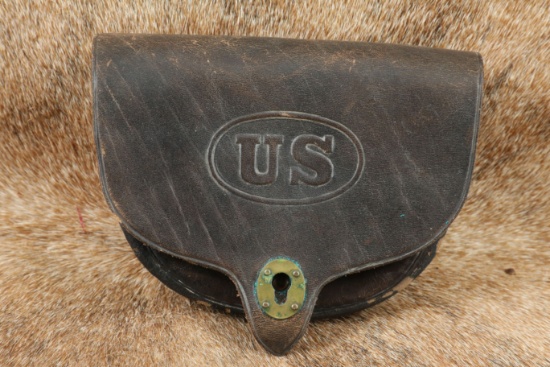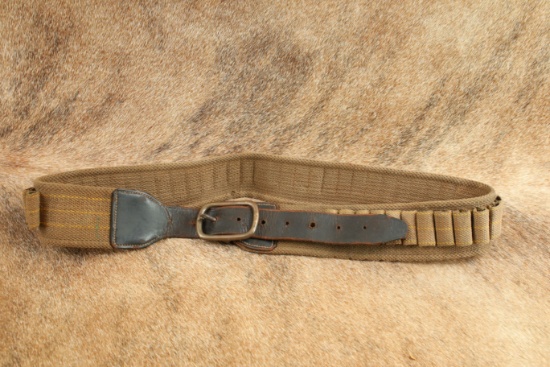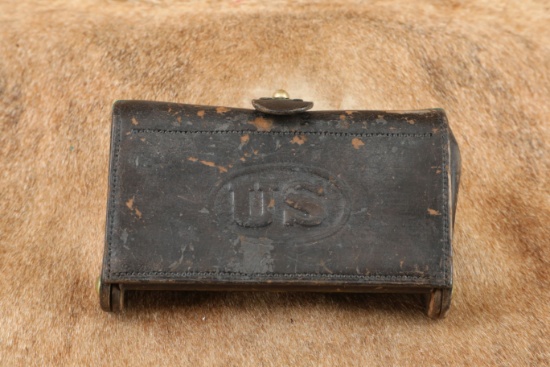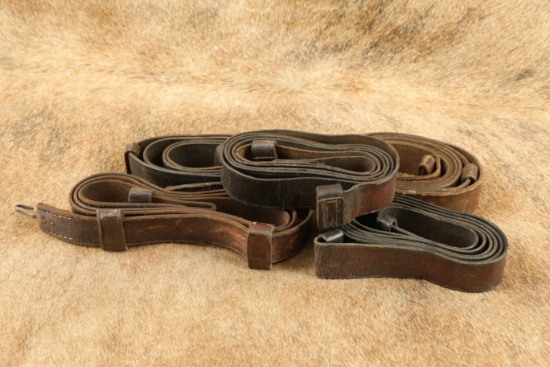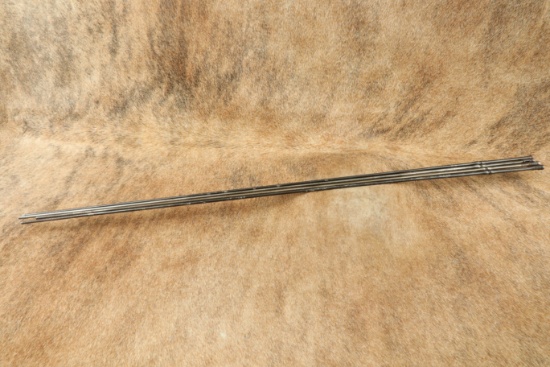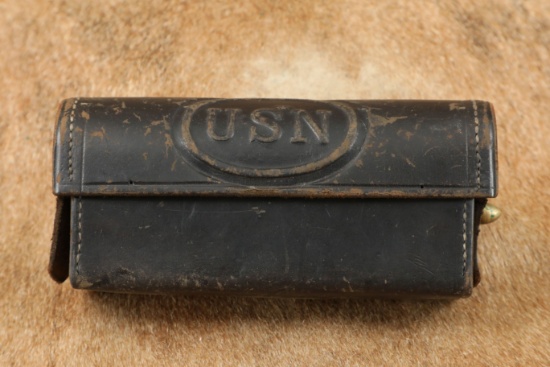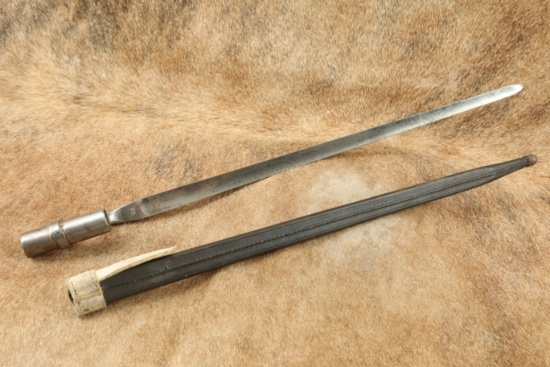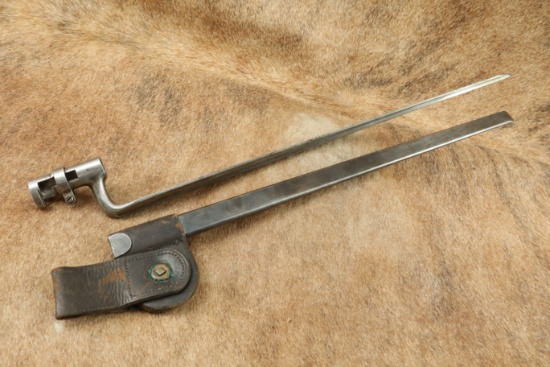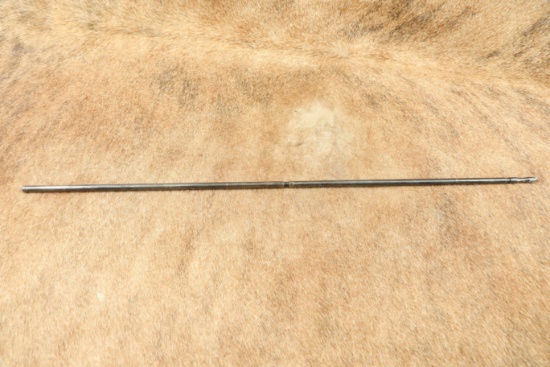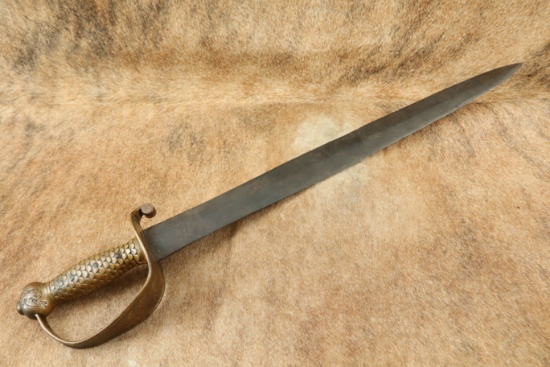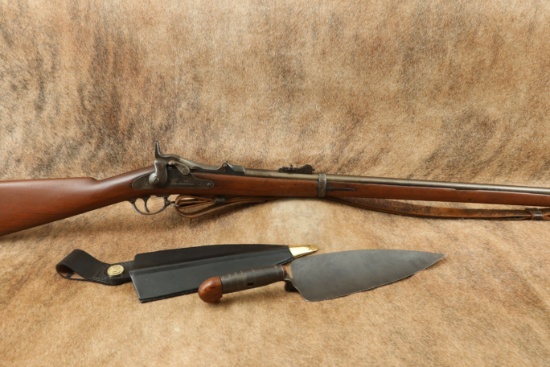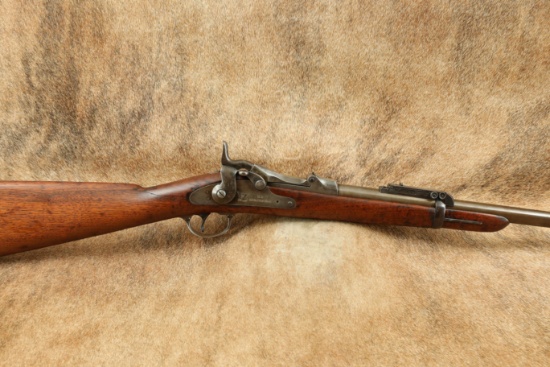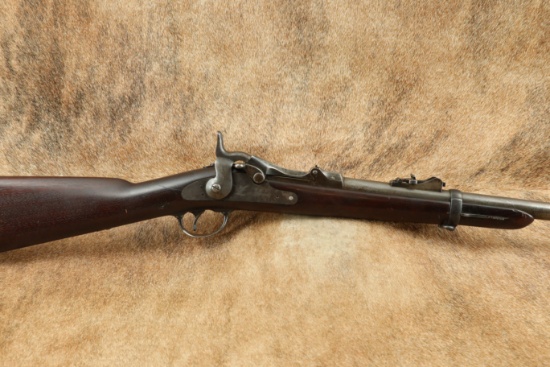.jpg)
Lock Stock Barrel Premier Auction May 2025 Day 2
Lock Stock Barrel Premier Auction May 2025 Day 2
See Special Terms for additional fees
Description
The auction will be held at The Cody Auditorium, 1240 Beck Ave, Cody, WY 82414, beginning at 9:00 MST.
Bidding will be available on LSBauctions.com, Proxibid, LiveAuctioneers & inValuable. You can fax or email sealed bids, arrange for phone bidding or bid live and in-person. There will be food and drink provided at the venue, so bring your appetites.
CANFIELD COLLECTION US Army Civil War Cavalry "G. PETERS" Marked Leather Carbine Socket Thimble
Lot # 1001 (Sale Order: 1 of 353)
The US Cavalry was mainly used as a raiding and screening force early in the Civil War, and was often humbled by General J.E.B. Stuart's superb Confederate horsemen. When General Ulysses S. Grant assumed control of all Union armies in March 1864, he immediately sought to improve his mounted forces, and placed General Philip Sheridan at the helm. Though not a veteran "horse soldier", Sheridan possessed two ideal traits for a cavalryman, a slight, wiry build and a bold, fiery spirit. Under his command, the US Cavalry evolved into a hard hitting strike force, capable of spearheading large attacks, and eventually cornering Lee and his army at Appomattox. Union cavaliers in the Civil War were issued leather carbine “sockets”, also called “thimbles”, which were buckled through a “D” ring on the right hand saddle skirt, allowing the trooper's slung carbine barrel to rest securely in the socket, and preventing that barrel from clanging against the horse and bouncing around while the rider was mounted. Many of those sockets were made by George Peters of Newark, New Jersey, who held a wartime contract for cavalry accoutrements. This US Army Civil War Cavalry “G. PETERS” Marked Leather Carbine Socket is in Good Condition, with moderate drying, surface cracking, and surface flaking to the outside strap, and with some overall drying, stiffening, crazing, and age wear evident. Most interestingly, it’s stamped on the end tip of the outside strap with its maker, “G. PETERS”, boasts the original black enameled steel closure buckle on that outside leather strap, and measures 2 1/2” long x 2 1/2” in diameter. A fine example of a very rare, original US Army Civil War Cavalry “G. PETERS” Marked Leather Carbine Socket. Lastly, this carbine socket comes directly from the personal collection of renowned US military firearms author and historian Bruce Canfield, and a signed letter of authenticity stating as such will accompany this piece.
CANFIELD COLLECTION US Army Indian Wars Cavalry Trapdoor Springfield Carbine M-1887 "Boot" Scabbard
Lot # 1002 (Sale Order: 2 of 353)
US Army cavalrymen out on the Plains in the Indian Wars were issued the Trapdoor Springfield carbine, as its shorter, lighter design made it easier to fire on horseback. The carbine was housed and attached to the saddle in the specially designed M-1887 "boot" scabbard, which featured a brass plate fixed to the front throat for reinforcement, and was longer than previous models for better stability. This US Army Indian Wars Cavalry Trapdoor Springfield Carbine M-1887 Leather "Boot" Scabbard is in Good Condition, with the maker’s mark having faded away long ago, and with moderate overall drying, stiffening, crazing, scuffing, surface cracking, and age wear evident. Most interestingly, it boasts the classic brass reinforcing plate at the front throat, sports the original leather cross straps with black enameled steel closure buckles, and features the original leather vertical suspension strap riveted to the upper back. It’s stamped with the inspector initials “F.A.H.” at the bottom front edge of the body, and is a fine example of a rare, original US Army Indian Wars Cavalry Trapdoor Springfield Carbine M-1887 Leather "Boot" Scabbard. Lastly, this boot scabbard comes directly from the personal collection of renowned US military firearms author and historian Bruce Canfield, and a signed letter of authenticity stating as such will accompany this piece.
Harpers Ferry U.S. Model 1841 2nd Style Percussion Cap & Ball 33” .58 Caliber Musket, 1851 Antique
Lot # 1003 (Sale Order: 3 of 353)
Make: Harpers Ferry
Model: 1841
Serial: None
Year of Manufacture: 1851
Caliber: .58 Caliber
Action Type: Single Shot, Percussion Cap
Barrel Length: 33 inches
Markings: The lock plate is marked "HARPERS FERRY 1851" with an American eagle and "US."
Sights / Optics: The front sight is missing. The rear sight is a replacement V-notch mounted near the chamber.
Stock Configuration & Condition: The wood stock shows heavy use with visible handling marks, scuffs, and scratches. There is a section of the stock missing from behind the hammer and a large dent or chunk missing behind the tang. A repair is present under the forearm, and a section near the front quarter on the right side is also missing. The stock retains its original profile but exhibits significant wear from age and use.
Fittings: The brass fittings, including a patch box on the right side of the buttstock, have been cleaned and polished. The front sling loop and the brass front leaf spring retainer have been replaced. A steel ramrod is included.
Finish: The barrel and steel parts exhibit speckling with erosion and corrosion.
Bore Condition: The bore is dark with scattered corrosion. In this writer’s opinion, the bore rates 6/10.
Overall Condition: This musket shows significant signs of age and wear. The finish is heavily eroded, with corrosion across most steel components. The brass fittings have been polished, and there are several replaced parts, including the front sling loop, brass front leaf spring cap retainer, and the rear sight. Despite its wear, the musket remains a fascinating piece of history.
Mechanics: The action functions correctly. We did not fire this musket. As with all used firearms, a thorough cleaning may be necessary to meet your maintenance standards.
Box, Paperwork & Accessories: None
Our Assessment: This Harpers Ferry 1841 musket is a fascinating piece of American history, produced during a time of significant military and industrial development. Marked "HARPERS FERRY 1851" on the lock plate, it features an American eagle and "US," denoting its government-issued origins.
While this musket shows heavy wear, with a dark bore, erosion, and corrosion throughout, it retains a strong historical presence. The brass fittings, including the patch box, have been polished, and several parts, including the front sling loop and rear sight, have been replaced. The stock shows extensive wear, with a section missing behind the hammer and a large dent or chunk missing behind the tang, in addition to other repairs and missing sections.
For collectors of antique firearms, Civil War-era weaponry, or U.S. military history, this musket is an intriguing piece. Though it shows its age, it offers an excellent opportunity for restoration, display, or study, highlighting the craftsmanship and utility of early American arms manufacturing. So bid high and bid firm. Please take a look at the condition of the rifle in our high-quality photos. Good luck with your bid.
Spencer Repeating Rifle Model 1865 30" .56-50 Springfield Rimfire Lever Action, 1860s Antique
Lot # 1004 (Sale Order: 4 of 353)
Make: Spencer Repeating Rifle Company
Model: 1865 Rifle
Serial Number: 2401
Year of Manufacture: 1863-1866
Caliber: .50 Springfield Carbine (.56-50 Spencer Rimfire)
Action Type: Lever Operated Repeating Rifle Fed By Tubular Magazine (not present)
Barrel Length: 30""
Sights / Optics: The front sight is a blade fixed to a slotted base fixed to the front of the barrel. The rear sight is a folding ladder sight. There is a ""V"" notch in the bottom of the sight for use when the ladder is folded down. When the ladder is raised, there is a ""U"" notch at the bottom of the ladder marked ""2"", a ""V"" notch on the slider with the ladder graduated 3-8, and another in the top edge of the ladder marked ""9"".
Stock Configuration & Condition: The stocks are two piece smooth walnut. The forend has a nosecap and three spring-clip secured bands with a sling swivel on the middle band. The forend is secured with a screw at the bottom-rear. The buttstock has a straight grip, straight comb, sling swivel in the belly and a steel semi-crescent buttplate with a hole for a tubular buttstock magazine. No magazine is included with this listing. The stocks have some scattered nicks, dings, scuffs and scratches. The wood shows discoloration from age and oil. There are a few minor cracks around the edges. The LOP measures 13"" from the front of the trigger to the back of the buttplate. The buttplate has some scattered light surface oxidation and erosion, most notable at the heel. The stocks rate in about Fine overall condition as Antique.
Type of Finish: Blue & Case Color
Finish Originality: The finish appears Original to the parts, we believe that the barrel is not original to the receiver (see Our Assessment).
Bore Condition: The 6-groove rifled bore is bright, tending to gray at the muzzle. The rifling is sharp. There is some minor oxidation and erosion throughout. In this writer’s opinion the bore rates 6/10.
Overall Condition: This rifle retains about 10% of its metal finish. Most of the remaining finish is in the barrel which has scattered minor surface oxidation and some spots of light surface erosion. The exposed portions of the receiver are worn to white with some case color visible inside the receiver and on the portions of the lever/breech-block assembly which are concealed when the action is open. The receiver and lever/breech-block assembly have some scattered minor surface oxidation and infrequent minor erosion. There are some light nicks, scuffs and scratches. The action shows operational wear. The screw heads range from sharp to tool marked with serviceable slots. The markings are clear. Overall, this rifle rates in about Very Good condition as Antique.
Mechanics: No magazine included. This rifle was originally equipped with a Stabler Cutoff device, it has been removed and a fill-screw installed. Otherwise, the action functions correctly. We have not fired this rifle. As with all used firearms, a thorough cleaning may be necessary to meet your maintenance standards.
Box, Paperwork & Accessories: None.
Our Assessment: Christopher Miner Spencer, a leading figure of the machine tool industry, developed this action. The Spencer carbine was different from any other firearm of its time, a repeater using a metallic cartridge. By the end of the Civil War, more than 144,000 Spencer rifles and carbines had been manufactured. Spencer rifles and carbines met with high praise from those who were equipped with them, and with respect from those who faced them in battle. In its first combat test, Spencer-armed Union troops under the command of Colonel John Wilder earned the nickname ""Lightning Brigade"" when they defeated a numerically superior Confederate force at the Battle of Hoover’s Gap.
This is a Spencer Rifle with an M1865 marked barrel, differing from its Civil War predecessor by having a .50 caliber bore instead of the earlier .52 caliber. The barrel is for an M1865 Rifle, but the serial number on the receiver is not in the range for this model, indicating that the barrel has been installed on an earlier receiver. The receiver was at one time equipped with a Stabler Cut-Off device, but it has been removed. The bore is quite good considering both the rifle's age and that it would have exclusive use of black powder. The stocks are also in quite good shape for their age. Find a magazine for this guy and it’ll be a great repeater, if not then you have a nice single shot rifle on your hands. This is a nice find for collectors of Civil War-era and other early American cartridge rifles.
"CANFIELD COLLECTION US Army Indian Wars Span-Am Trapdoor Springfield & Krag 2-Claw Leather Sling
Lot # 1005 (Sale Order: 5 of 353)
This is an original U.S. military 2-claw leather rifle sling from the Canfield Collection, dating from the Indian Wars through the Spanish-American War era (circa 1870s–1900). Designed for use with both the Springfield Trapdoor rifles and Krag–Jørgensen rifles, this pattern of sling features two brass claws for adjustable length and heavy russet leather construction. It saw widespread use by American infantry on the frontier and overseas during the nation’s late 19th-century conflicts. The leather remains pliable with moderate age cracking and wear, while the brass claws show a deep, untouched patina. Stitching remains strong and secure. Though unmarked, its design and wear are consistent with government-issue slings of the era. Measuring approximately 64 inches in length and 1¼ inches wide, this piece is ideal for pairing with an original service rifle or as a standalone collector’s item. Sourced from the well-known Canfield Collection, this is a fine, authentic example of a late 19th-century U.S. Army rifle sling—rich in history and essential for completing a proper Indian Wars or Span-Am rifle display.
CANFIELD COLLECTION US Army Frankford Arsenal .45-70 Trapdoor Springfield Wooden Cartridge Crate
Lot # 1006 (Sale Order: 6 of 353)
This rare and original Frankford Arsenal wooden ammunition crate, dated April 21, 1881 (4-21-81), was designed to hold .45-70 cartridges for Trapdoor Springfield Rifles. With clear period markings, including “Caliber .45” and “Frankford Arsenal,” this crate is a true survivor of the Indian Wars era. Most of these crates were repurposed or destroyed, making well-preserved examples like this incredibly scarce. The wood retains its rich patina, and the stenciling remains visible, adding to its historical appeal.
For collectors of U.S. military artifacts and historical firearms memorabilia, this crate is a fantastic find. It serves as both a striking display piece and an authentic relic of the 19th-century U.S. Ordnance Department, embodying a time when these ammunition boxes played a critical role in arming frontier troops.
CANFIELD COLLECTION US Army Indian Wars M1879 Trials Prairie Belt & Socket Bayonet, Sheath, & Frog
Lot # 1007 (Sale Order: 7 of 353)
This rare Model 1876 cartridge belt with 1879 trial modifications represents a fascinating and highly collectible piece of U.S. military history. Designed as part of the Army’s effort to improve soldier equipment in the post-Civil War era, this belt features its distinctive varnished canvas construction with integral cartridge loops and a leather-reinforced tongue. The rare single hook bayonet scabbard, an experimental feature unique to these trials modifications, remains intact and accompanies an M1873 socket bayonet, completing this exceptional set. The belt’s aged but well-preserved condition showcases the craftsmanship and durability of the period, making it an outstanding addition for collectors of Indian Wars and frontier military gear.
Surviving examples of the 1879 trial-modified Prairie Belts are scarce, and even fewer retain their original single hook bayonet scabbard—a rare and short-lived feature in U.S. Army equipment history. The attached M1873 socket bayonet, designed for the Springfield Trapdoor rifle, pairs perfectly with the belt, further enhancing its historical significance. The belt’s rich patina, solid stitching, and well-preserved brass hardware all contribute to its authenticity and appeal. Whether as a museum-quality display piece or a highlight of an advanced militaria collection, this belt and bayonet set is a tangible connection to the evolving gear of the U.S. Army during the Indian Wars period.
CANFIELD COLLECTION US Army Indian Wars Hagner No. 2 Trapdoor Springfield Leather Ammo Pouch, Round
Lot # 1008 (Sale Order: 8 of 353)
Step back in time to the days of the U.S. Army's Indian Wars with this incredible early Hagner Number 2 leather ammunition pouch, a true relic of the late 19th century! Designed to carry .45-70 cartridges for the iconic Trapdoor Springfield rifles, this ruggedly constructed pouch was standard issue for frontier soldiers navigating the vast and untamed American West. Featuring the classic embossed "US" oval on the flap, sturdy brass hardware, and an interior lined with cartridge loops, this piece was built for durability and function in harsh conditions. The deep, rich patina on the leather, the verdigris on the rivets, and the wear from use all tell the story of a piece of equipment that saw real service in the hands of a soldier.
Adding to its authenticity and appeal, this pouch even includes a period-correct .45-70 round, a rare find that enhances its historical value! Whether you’re a collector of Indian Wars militaria, a historian, or simply someone who appreciates tangible pieces of American frontier history, this Hagner No. 2 pouch is a must-have. Its connection to the soldiers who carried it into battle and across the plains makes it an evocative piece of history that speaks of duty, hardship, and the expansion of a nation. Don’t miss the chance to own this remarkable artifact from a defining era in American military history!
CANFIELD COLLECTION US Army Indian Wars Hagner No. 1 Trapdoor Springfield Leather Ammo Pouch, Round
Lot # 1009 (Sale Order: 9 of 353)
This is a scarce and desirable Indian Wars-era Hagner No. 1 leather cartridge pouch, designed for use with the .50-70 Government cartridges issued for the Springfield Trapdoor rifles and carbines. This particular example comes from the Canfield Collection, known for its well-preserved and historically significant military artifacts. The pouch still retains a single .45-70 round, likely added during the late Indian Wars period when the U.S. military transitioned to the updated cartridge in the 1870s. The Hagner No. 1 was one of the earliest standardized cartridge pouches adopted following the Civil War, issued in the early 1870s as the Army transitioned from percussion muzzleloaders to breechloading rifles. This early pattern features the distinctive front flap secured by a brass finial, with leather belt loops on the reverse and original stitching throughout. Though designed for .50-70 ammunition, this example’s continued service into the .45-70 era reflects how slowly surplus equipment was phased out on the frontier. The leather remains supple and well cared for, showing an attractive aged patina. The pouch flap is clearly stamped with the “US” oval, and the construction remains solid with no tears or major cracking. It includes a single period-correct .45-70 cartridge nestled inside, offering a small but authentic touch of frontier soldier life. This is a fine example of early Indian Wars field gear, and one that rarely appears on the market in such complete condition. Whether you are a collector of U.S. military leather, frontier arms, or Indian Wars militaria, this Hagner No. 1 pouch from the Canfield Collection is a superb piece of 19th-century Army history.
CANFIELD COLLECTION US Army Indian Wars Cavalry Trapdoor Springfield Carbine M1874 Dyer Ammo Pouch
Lot # 1010 (Sale Order: 10 of 353)
US Army cavalrymen out on the Plains in the Indian Wars faced many dangers during their arduous campaigns. Those intrepid horsemen manned isolated forts along the trails out West, protected settlers, miners, and railroad crews from "hostiles", and brought renegade bands back onto the reservation. They were issued the classic M-1873 "Trapdoor" Springfield Carbine, and early on, before the advent of the widespread adoption of the Prairie belt or the introduction of the McKeever pouch, ammo for the Trapdoor Carbine was carried in the specially designed M-1874 Dyer ammo pouch. This US Army Indian Wars Cavalry Trapdoor Springfield Carbine M-1874 Dyer Leather Ammo Pouch is in Good Condition, with moderate overall drying, surface cracking, fragility, and age wear evident. Most interestingly, it bears the classic “US” oval embossed marking at front, sports a fully functional brass stud and brass escutcheon closure flap, and is stamped at the upper back with its maker, the famous “ROCK ISLAND / ARSENAL”. It features fully intact sewn and riveted belt loops at the reverse, exhibits a sheep’s wool lining to keep loose rounds from rattling, and is a fine example of a very rare, original US Army Indian Wars Cavalry Trapdoor Springfield Carbine M-1874 Dyer Leather Ammo Pouch. Lastly, this ammo pouch comes directly from the personal collection of renowned US military firearms author and historian Bruce Canfield, and a signed letter of authenticity stating as such will accompany this piece.
CANFIELD COLLECTION US Army Indian Wars Cavalry "E.A. CROSSMAN" Marked Leather Carbine Sling
Lot # 1011 (Sale Order: 11 of 353)
US Army cavalrymen in the early days of the post-bellum Indian Wars were largely issued the Spencer and Sharps carbines before the M-1873 Trapdoor Springfield Carbine was introduced. Those early carbines used a specially designed leather shoulder sling, modeled after those of the Civil War, but scaled down to a more narrow width. Designed to support a cavalry carbine while on horseback, the long sling looped over the trooper’s shoulder and hooked to the saddle ring on his carbine. This US Army Indian Wars Cavalry "E.A. CROSSMAN" Marked Leather Carbine Sling is in Good Condition, with some overall drying, fragility, and age wear evident. Most interestingly, it boasts the classic post-Civil War “narrow width” design, sports a fully intact brass closure buckle and a thick steel snap hook to attach to the saddle ring on the carbine, and is stamped at the middle back with the oval logo of its maker, “E.A. CROSSMAN & Co. / NEWARK / -N.J.-”. E.A. Crossman & Co. was listed in the Newark directories as a harness maker during the 1860s, and the firm changed its name to E.A. Crossman Jr. in 1868, dating this piece to ca. 1866-1868. A fine example of a very rare, original US Army Indian Wars Cavalry "E.A. CROSSMAN" Marked Leather Carbine Sling. Lastly, this carbine sling comes directly from the personal collection of renowned US military firearms author and historian Bruce Canfield, and a signed letter of authenticity stating as such will accompany this piece.
CANFIELD COLLECTION US Army Indian Wars .45-70 Trapdoor Springfield M-1876 Canvas Prairie Belt
Lot # 1012 (Sale Order: 12 of 353)
This original U.S. Army M-1876 canvas prairie belt, designed for .45-70 Springfield Trapdoor cartridges, dates to the Indian Wars period and comes from the esteemed Canfield Collection. Issued in the late 1870s through the 1880s, it features 50 brass-reinforced cartridge loops, a “C” hook closure, and original brass hardware including the front adjustment buckle. Manufactured at Watervliet Arsenal, this belt was standard gear for troops on the Great Plains. The khaki-toned canvas shows honest service wear but remains strong and fully intact, with faint arsenal markings still visible—an iconic piece of frontier military history.
CANFIELD COLLECTION US Army Trapdoor Springfield Anson Mills McKeever Cartridge Box, Nipple Wrench
Lot # 1013 (Sale Order: 13 of 353)
Own a true piece of frontier history with this original Indian Wars-era U.S. Army McKeever Cartridge Box, complete with an authentic .45-70 Government cartridge and Springfield Trapdoor combination tool! Issued to soldiers armed with the legendary Springfield Trapdoor rifle, this rugged black leather case features the bold “US” oval stamp, a proud emblem of military service on the American frontier. Inside, the canvas cartridge loops remain intact, designed to hold .45-70 rounds, just like the one included with this set! The brass hardware and latch are still functional, preserving the box’s historical integrity while offering a glimpse into the daily life of 19th-century U.S. soldiers.
Adding to its collector’s appeal, this set includes an original Springfield Trapdoor combination tool, an essential accessory used by soldiers for maintaining their rifles in the field. With the bonus of a genuine .45-70 round, this is a complete, museum-worthy set—ideal for collectors, reenactors, and enthusiasts of America’s Indian Wars era. Whether displayed in your collection or used as an authentic addition to your historical gear, this McKeever cartridge box, tool, and cartridge combo is an unbeatable find!
CANFIELD COLLECTION Lot of 5x US Army Indian Wars Trapdoor/Sharps Single Claw Leather Rifle Slings
Lot # 1014 (Sale Order: 14 of 353)
This lot includes five original U.S. Army single claw leather rifle slings from the Indian Wars period, suitable for use with Trapdoor Springfield rifles as well as Spencer and Sharps conversion carbines. These slings are constructed of thick russet leather and each features a single brass hook, typical of the post-Civil War U.S. military sling design prior to the adoption of the M1907 double claw pattern. The leather shows expected age with surface crazing, darkening, and some cracking, but several slings remain supple enough for display. Brass hardware shows a deep, aged patina. These slings are representative of the kind issued during the 1870s and 1880s as the U.S. Army transitioned into a modernized frontier force. They are a fitting addition for collectors of Indian Wars militaria or anyone looking to complete a period-correct display of Springfield, Spencer, or Sharps rifles and carbines.
CANFIELD COLLECTION Lot of 4x US Army Indian Wars M-1873 Trapdoor Springfield .45-70 Cleaning Rods
Lot # 1015 (Sale Order: 15 of 353)
This lot consists of four original U.S. Army cleaning rods designed for use with the M-1873 Trapdoor Springfield rifle, the standard infantry weapon throughout the Indian Wars era. Each rod is approximately 35 inches in length and features the correct slotted tip for patch cleaning, along with threaded ends to accommodate standard issue brushes and attachments. These steel rods were stored beneath the rifle barrel and were an essential part of field maintenance for soldiers on campaign in the post-Civil War American West. The rods exhibit uniform aging, with surface wear and a mild, even patina consistent with extended service use. Threads remain intact, and there are no signs of bending, cracking, or structural damage. These are 100% original military-issue components, not reproductions, and are well suited for display alongside Trapdoor rifles or as replacements for period-correct restorations. A fine example of late 19th-century U.S. Army gear, this grouping comes from the esteemed Canfield Collection and represents a valuable opportunity to acquire authentic accoutrements from one of the most iconic rifles in American military history.
CANFIELD COLLECTION US Navy Indian Wars .45-70 Trapdoor Springfield M-1879 Hitchcock Cartridge Box
Lot # 1016 (Sale Order: 16 of 353)
Step into the frontier legacy with this US Navy Indian Wars-era Trapdoor Springfield M-1879 cartridge box, an authentic piece of American military history! Crafted by Hitchcock of St. Louis, this original leather cartridge box was designed to hold powerful .45-70 Government rounds—ammunition that fueled the iconic single-shot Trapdoor rifles of the late 19th century. What makes this example truly special is its military provenance, with clear “USN” (United States Navy) markings and a single original .45-70 round still tucked inside—an evocative reminder of the sailors and Marines who once carried these into battle or aboard ship.
The condition of the leather is a testament to its quality and resilience, with the box retaining a pleasing, aged patina that only comes with genuine use and time. The stitching remains strong, and the Hitchcock maker’s mark is still crisply visible on the inner flap, adding collectability and authentication. Whether you're a serious Indian Wars collector, a reenactor, or simply someone who values tangible links to America's martial past, this cartridge box offers a rare chance to own a functional and display-worthy artifact from the era when the Trapdoor Springfield ruled the ranks.
CANFIELD COLLECTION US Union Army Civil War M-1861 M-1863 Springfield M-1855 Socket Bayonet & Sheath
Lot # 1017 (Sale Order: 17 of 353)
Union infantrymen in the Civil War, colloquially nicknamed ”Billy Yank”, were largely armed with the superb Springfield rifle musket. The Springfield was renowned for its accuracy and range, and mounted a well made socket bayonet for close quarters combat. Undoubtedly the most famous bayonet charge of the “War Between the States” was executed by Colonel Joshua Chamberlain and his 20th Maine, in what became known as “Chamberlain’s Charge” down Little Round Top on the second day of the pivotal Battle of Gettysburg in July 1863. This US Union Army Civil War M-1861 M-1863 Springfield M-1855 Socket Bayonet is in Very Good Condition, with some light overall cleaning, scratching, pitting, spot patina, and age wear evident. Most interestingly, it features an 18" bright trefoil blade that was factory left “in the white”, sports a fully functional locking ring at the mortise, and is "US" stamped with serifs at the ricasso, above the serifed inspector’s initial “S”. It’s complete with the original US Union Army Civil War Leather Scabbard in Good Condition, with heavy drying, surface cracking, and surface flaking to the body, and with moderate overall age wear evident. Most interestingly, it bears an integral “roughout” leather frog riveted at top, exhibits a brass reinforced end tip with a “ball” finial at bottom, and the set is a fine example of a rare, original US Union Army Civil War M-1861 M-1863 Springfield M-1855 Socket Bayonet. Lastly, this bayonet and scabbard come directly from the personal collection of renowned US military firearms author and historian Bruce Canfield, and a signed letter of authenticity stating as such will accompany this set.
CANFIELD COLLECTION US Union Army Civil War Springfield M-1855 Socket Bayonet & British Sheath
Lot # 1018 (Sale Order: 18 of 353)
This is an original U.S. Union Army Model 1855 socket bayonet from the Civil War era, paired with a British leather sheath. The bayonet features the classic triangular blade design with an intact socket and locking ring, measuring approximately 18 inches in length. Designed for use with the .58 caliber Springfield rifles—including the Model 1855, 1861, and 1863—the M-1855 bayonet became a staple in Union infantry gear. This example shows a smooth, aged steel patina with light surface wear consistent with its period of use. The accompanying British scabbard adds character and historical intrigue. Leather is lightly worn but in Very Good condition, with brass throat and tip still present. Such combinations were not uncommon, especially in postwar or field-modified gear where practicality often overruled uniformity. This piece comes from the respected Canfield Collection and represents a fine example of a classic Civil War-era bayonet, suitable for any collector of 19th-century military arms and accoutrements.
CANFIELD COLLECTION US Indian Wars Unmarked M-1873 Trapdoor Springfield Bayonet & Sheath "USN" Frog
Lot # 1019 (Sale Order: 19 of 353)
Offered here is an original Model 1873 triangular socket bayonet for the Springfield Trapdoor rifle, paired with its original metal scabbard and a Navy-marked leather frog. This example comes from the esteemed Canfield Collection and is representative of the period of the Indian Wars, when the Springfield Trapdoor rifle was the primary service longarm of the U.S. military. The bayonet is unmarked, as is correct for many M1873 examples produced early in the Trapdoor era, featuring the distinctive triangular blade with crisp edges and a clean, full-length profile. The locking ring at the socket is intact and functional. The scabbard is the early second pattern with a blued finish and brass tip, showing honest wear from use but remaining structurally sound. This is an amazing piece of history and will be a perfect addition to any collection.
CANFIELD COLLECTION US Army Philippine Insurrection Pre-WW1 M-1903 Springfield Rifle Rod Bayonet
Lot # 1020 (Sale Order: 20 of 353)
This is an original U.S. Springfield Model 1903 Rod Bayonet, a scarce and historically significant piece designed for the earliest configuration of the M1903 rifle, produced prior to the 1905 redesign. Manufactured at Springfield Armory, this blued steel bayonet features a needle-like design reflecting the influence of European military trends at the turn of the century. Rod bayonets were issued in extremely limited numbers before President Theodore Roosevelt personally intervened, calling the design "as poor an invention as I ever saw," leading to their rapid withdrawal and replacement with knife-type bayonets. As a result, surviving examples—especially in original, unmodified condition—are exceedingly rare. This particular bayonet has some light surface oxidation present but remains in Very Good condition. This is a must have item for collectors.
CANFIELD COLLECTION US Army Indian Wars M-1873 Trapdoor Springfield Socket Bayonet & Sheath W/ Frog
Lot # 1021 (Sale Order: 21 of 353)
This original U.S. Army Model 1873 socket bayonet was designed for use with the Springfield Trapdoor rifle in .45-70 Government and dates to the Indian Wars era of the 1870s–1890s. It features an 18-inch triangular blade with a crisp "US" marking at the base and a functional locking ring at the socket. The steel blade has aged to a smooth plum-gray patina, and it comes complete with its original blued steel scabbard and a rare period leather frog. The scabbard shows some light surface oxidation but has no dents, while the leather frog remains supple with intact stitching—an uncommon survival due to field use and age. Issued to frontier infantry during campaigns in the American West, this bayonet represents a key piece of U.S. military history. Sourced from the respected Canfield Collection, this is a well-preserved and complete Indian Wars-era bayonet rig with strong appeal to collectors of 19th-century militaria.
Ames Model 1841 U.S. Naval Cutlass, 26” Mexican War Dated 1846 Sword
Lot # 1022 (Sale Order: 22 of 353)
Maker: N.P. Ames, Springfield, Massachusetts
Model: 1841 U.S. Naval Cutlass
Date: 1846
Blade Length: Approximately 21” (standard regulation length)
Overall Length: Approximately 26”
Markings:
The reverse ricasso of the blade is marked “N.P. AMES / SPRINGFIELD,” partially rubbed but still legible. The obverse side is marked at the ricasso with partially visible “USN” above a clearly stamped “1846” date. Below this is a faint but recognizable inspector’s stamp “R,” commonly encountered on other Model 1841 cutlasses but not specifically identified. The brass hilt shows clear inspector stamps: “R.C.” (Rufus Chandler, Navy Bureau of Ordnance inspector) on the reverse quillon disk and “J.L.” within an oval (Joseph Lanman, U.S. Navy inspector) on the obverse quillon disk. Both inspection marks feature a line of small check marks across them, typically found on surplus-disposed naval weapons. The cast eagle motifs on each side of the pommel remain distinct and sharp. The underside of the brass handguard is marked ""55 / 90"".
Blade Configuration & Condition:
This regulation double-edged blade features a central median ridge without fullers, characteristic of the M1841 naval pattern. The blade has a bluish-gray patina overall with thin, darker gray areas and exhibits some shallow, scattered pitting consistent with maritime use and age. The cutting edges show only minor nicks, nothing severe, and the blade retains a good, sharp point. Markings on the ricasso remain partially clear despite having been worn by periodic cleaning throughout its service life.
Hilt Configuration & Condition:
The brass guard and pommel have acquired an even, medium-aged patina. The guard design includes a reinforced knuckleguard extending downward into a wide, counterguard ending with a quillon terminating in a disk. The reverse disk is marked ""R.C."" and the obverse ""J.L."" in an oval, both clearly stamped. The pommel castings, featuring an eagle on both sides, show slight wear but retain clear outlines and definition. Overall, the hilt remains solid and attractive, reflecting genuine handling and use, with no damage or structural issues.
Historical Assessment:
The Ames Model 1841 U.S. Naval Cutlass is historically significant and notably scarce, with only 6,600 units produced between 1842-1846. The clearly stamped date ""1846"" places this cutlass within the batch of 1,200 produced on the September 21, 1844, contract and delivered by September 1845, or possibly among a smaller subsequent batch from July 1846. These cutlasses played active roles throughout the Mexican-American War (1846-1848), notably at Vera Cruz in 1847 and other naval actions along the Gulf Coast and in California. Afterward, they saw widespread naval service, including Commodore Perry’s expedition to China and Japan, and remained the standard-issue naval cutlass up to and into the early stages of the American Civil War.
These rugged naval blades, inspired partly by the U.S. Army’s earlier 1832/33 pattern short sword, proved versatile in shipboard combat and utility tasks, effectively cutting through boarding nets or handling rigging emergencies. Their historical use through multiple conflicts and their ongoing presence aboard U.S. Navy ships worldwide adds considerably to their desirability and collectible status.
This particular example is a very good representative piece of American naval history. It shows genuine use and careful handling, retains legible markings, inspector’s stamps, and distinct, attractive patina—exactly what collectors seek in authentic naval antiques. The ""55/90"" marking beneath the guard suggests a shipboard rack or inventory marking, adding another layer of historical intrigue. The clear 1846 dating, confirmed Ames maker marks, and documented inspector’s stamps provide strong provenance and historical integrity, making this Model 1841 Naval Cutlass an outstanding candidate for inclusion in any serious collection of American naval and edged weaponry.
"Springfield Model 1873 Trapdoor .45-70 Gov’t 32 5/8” Single-Shot Rifle with Bayonet Antique 1876
Lot # 1023 (Sale Order: 23 of 353)
Make: Springfield Armory
Model: 1873 Trapdoor
Serial#: 63174
Year of Manufacture: 1876 (Antique)
Caliber: .45-70 Government
Action Type: Single-Shot Trapdoor Breech-Loading Rifle
Markings: The lock plate is marked "US SPRINGFIELD". The rear of the receiver is marked "63174". The top of the trapdoor is marked "Model 1873" over an "eagle head" over "US". The chamber is marked "MASS". The buttplate is marked "US".
Barrel Length: 32 ?”
Sights / Optics: The front sight is a blade fixed to a rectangular base on the barrel. The rear sight is a leaf sight with stepped sight leaves, adjustable for elevation.
Stock Configuration & Condition / Grip: The stock is a one-piece walnut military-style stock with straight grip, showing scattered dings, scratches, and handling marks consistent with age and military use. The buttstock exhibits notable grain separation and striations starting at the heel, which does not affect the structural integrity or usefulness of the stock. A sling is installed. Overall, the stock rates in Good condition as Antique.
Type of Finish: In the White, developing patina throughout
Finish Originality: Original
Bore Condition: The bore is dark with visible rifling. There is mild erosion throughout. In this writer’s opinion, the bore rates 5/10.
Overall Condition: This rifle is essentially in the white with an even patina throughout. The metal surfaces exhibit scattered pitting and age-related wear, consistent with prolonged use and storage. The screwheads show moderate use with defined slots. All markings remain clear and legible. Overall, this rifle is in Good condition as Antique.
Mechanics: The action functions correctly. We did not fire this rifle. As with all previously owned firearms, a thorough cleaning may be necessary to meet your maintenance standards.
Box Paperwork and Accessories: The rifle includes an installed cleaning rod (ramrod) and a trowel-style bayonet housed in a leather frog. The frog carries a tag marked "Made in India". The bayonet and frog are modern reproductions and are in Very Good condition.
Our Assessment: This Springfield Model 1873 Trapdoor rifle, serial number 63174, was manufactured in 1876, a historically significant centennial year for the United States. Chambered in .45-70 Government, the Model 1873 Trapdoor rifle was extensively utilized during the Indian Wars era and became an iconic symbol of post-Civil War American military arms.
This particular rifle features Massachusetts militia ("MASS") markings, indicating a storied past. Its honest wear, patinated surfaces, and grain separation in the buttstock speak to genuine historical usage without compromising the stock's structural integrity. Complete with a reproduction trowel bayonet in a leather frog, it offers historical appeal to collectors and reenactors.
Springfield Model 1884 Carbine .45-70 Government Trapdoor Single Shot Rifle 22"C&R MFD 1889
Lot # 1024 (Sale Order: 24 of 353)
Make: Springfield Armory
Model: 1884 Trapdoor Rifle
Serial Number: 451990
Year of Manufacture: 1889, C&R
Caliber: .45-70 Government
Action Type: Single Shot, Trapdoor Action, Fed by Single Shot
Markings: The right side of the barrel near the breech is marked “V / P / Eagle Head / P.” The breechblock is marked “U.S. / MODEL / 1884.” The top of the buttplate is marked “U.S.” The top of the receiver is marked with the serial number “451990.”
Barrel Length: 22”
Sights / Optics: The front sight is a blade set in a base that doubles as a bayonet lug. The rear sight is a Buffington sight adjustable for windage and elevation, marked to 2,000 yards. The rear sight base is intact and secure.
Stock Configuration & Condition: The stock is a one-piece walnut military stock with a straight grip and metal buttplate. The LOP measures 13 3/8” from the front of the trigger to the back of the buttplate. The stock shows handling marks throughout with several scattered nicks, small gouges, and scratches. There is a crack around the top of the wrist. The stock rates in about Good overall condition.
Magazine Quantity & Condition: N/A – Single shot
Type of Finish: Blued with case-colored breechblock
Finish Originality: Original
Bore Condition: The bore is mostly bright, the rifling is defined. There is light visible erosion in the bore. In this writer’s opinion, the bore rates 7/10.
Overall Condition: This rifle retains about 50% of its metal finish. The balance of the finish shows general thinning and finish loss, with areas of patina developing along the barrel and receiver. There is light surface oxidation and some freckling, particularly on the buttplate and exposed metal parts. The breechblock retains strong case color. The screw heads are lightly tooled with serviceable slots. The pins are unmarred. The markings are mostly sharp and legible. Overall, this rifle rates in about Good condition.
Mechanics: The action functions correctly. We did not fire this rifle. As with all used firearms, a thorough cleaning may be necessary to meet your maintenance requirements.
Box, Paperwork & Accessories: None
Our Assessment: The Springfield Model 1884 Trapdoor Rifle was the final iteration of the long-serving Trapdoor series used by the U.S. military from the late 1860s through the end of the 19th century. Featuring the improved Buffington rear sight and robust .45-70 Government chambering, these rifles saw service in the Indian Wars and into the Spanish-American War era as training and secondary arms.
This particular example, serial number 451990, dates to circa 1889 and retains solid mechanical function, clear markings, and a bright bore with strong rifling. Though showing wear consistent with age and service, it presents as a very honest, well-preserved military rifle.
For collectors of U.S. military arms, especially 19th-century martial rifles, this Springfield Trapdoor offers historical value, shooting potential, and an iconic design that bridges the black powder and early smokeless eras. A solid addition to any historical arms collection.
Springfield Model 1873 Cavalry Carbine .45-70 Government 22” Trapdoor Single Shot Rifle MFD 1884
Lot # 1025 (Sale Order: 25 of 353)
Make: Springfield Armory
Model: Model 1873 Trapdoor Carbine
Serial Number: 254357
Year of Manufacture: 1884 (Antique)
Caliber: .45-70 Government
Action Type: Trapdoor Breechblock, Single Shot
Markings: The serial number “254357” is located at the top of the receiver behind the breechblock. The breechblock is marked “U.S. / MODEL / 1873” as well. The barrel is marked with a “V / P / eaglehead” proof on the left side near the breech. The lockplate is marked “U.S. / SPRINGFIELD” with the eagle motif in between. The rear sight base is marked “C” for carbine. There are no visible cartouches on the left side of the stock due to wear. The buttplate tang is marked “U.S.” and the cleaning rod and trapdoor is intact.
Barrel Length: 22”
Sights / Optics: The front sight is a blade pinned in a base. The rear sight is a folding leaf sight marked “C” with a fixed “V” notch at the base and an elevator bar with additional notches for elevation.
Stock Configuration & Condition: The stock is a one-piece straight grip walnut carbine stock with a short forearm secured by a single barrel band. The LOP measures 13 1/8” from the front of the trigger to the back of the steel carbine buttplate. The stock shows handling marks throughout. There is mild wear around the lockplate and wrist. There is a crack on the right side of the wrist. The stock rates in about Good overall condition.
Magazine Quantity & Condition: Not applicable. This is a single shot rifle.
Type of Finish: Blued and Case Colored
Finish Originality: Original
Bore Condition: The bore is semi-bright, the rifling is mostly sharp. There is light scattered visible erosion in the bore. In this writer’s opinion, the bore rates 8/10.
Overall Condition: This rifle retains about 20% of its metal finish. The balance of the finish shows thinning and wear from age and use. The case coloring on the breechblock has mostly faded to patina. There is general handling wear with scattered nicks, spots of oxidation, pitting throughout the barrel, and faint surface freckling. The screw heads are lightly tooled with serviceable slots. The pins are unmarred. The markings are mostly sharp and legible. Overall, this rifle rates in about Good condition.
Mechanics: The action functions correctly. We did not fire this rifle. As with all used firearms, a thorough cleaning may be necessary to meet your maintenance requirements.
Box, Paperwork & Accessories: None
Our Assessment: The Springfield Model 1873 “Trapdoor” Carbine was the standard U.S. cavalry longarm from the Indian Wars through the mid-1880s. Its robust, simple trapdoor mechanism was an evolution from the Civil War-era Allin conversions, chambered in the powerful .45-70 Government cartridge. This particular example, made in 1884, represents the final years of this model before the adoption of the bolt-action Krag-Jørgensen.
This carbine retains many of the original features expected on cavalry-issue Trapdoors, including the 22” barrel, “C”-marked carbine rear sight, and buttplate with cleaning rod trap. The patina and wear are consistent with a field-used but well-preserved military weapon, and the sharpness of the bore is particularly impressive for a black powder-era gun. While the stock shows honest age and wear, the action is tight and the markings remain mostly clear.
Collectors of American military arms will appreciate this carbine for its historical value and its configuration as a true cavalry-issued example. Whether for historical reenactments, display, or a curated U.S. martial collection, this Springfield Model 1873 stands as an enduring piece of 19th-century American frontier and military history.


 x Cancel
x Cancel